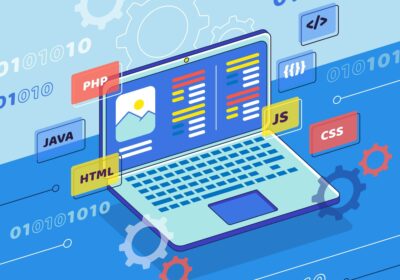The digital age has made websites or applications a starting point of interaction for the firm with its customers. So, the quality of user experience (UX) and UI design will play an imperative role in determining how such platforms can succeed. Seamless and intuitive design leads to greater user satisfaction, increased conversion, and even long-term relationships between customers.
We understand that good UX/UI design is a marriage of art and science – where creativity meets functionality. Here’s a step-by-step guide to walk you through the UX/UI design process, explaining how we at Verbat ensure that every design we create is user-centered, visually compelling, and functionally robust.
What is UX/UI Design?
Before diving into the process, let’s clarify what UX and UI stand for and their importance in the digital design world.
- User Experience (UX): UX design is all about the overall experience a user has while interacting with a digital product, such as a website or mobile app. It involves ensuring that the product is easy to navigate, efficient to use, and delivers a satisfying interaction.
- User Interface (UI): UI design is the visual aspect of a digital product. This includes everything from buttons and icons to typography, color schemes, and layout. UI design ensures that the product looks aesthetically pleasing and is consistent with the brand.
Where UX concerns itself with functionality as well as experience, the UI pertains to aspects of appearance as well as interactivity. In order for overall user experience to result, working on both areas is paramount.
The Process of UX/UI Design at Verbat
At Verbat, we follow a defined and cyclical UX/UI design process that helps deliver intuitive, user-friendly, and also visually pleasing products. Here’s a step-by-step guide for our design process:
- Discovery & Research
The first phase of design is to get to the bottom of the client’s business, target audience, goals, and objectives. For Verbat, the discovery phase starts by engaging stakeholders to understand the company’s vision, pain points, and long-term goals. This includes understanding the user’s needs and pain points through surveys, interviews, and observing their behavior.
- Market Research & Competitor Analysis: To have a deep understanding of the market and industry trends, we analyze competitors and industry leaders.
From this information, we make sure that the design process is grounded in the real needs of users and the business.
- Personas & User Journey Mapping
From the research phase, we come up with user personas and user journey maps. These tools help define key characteristics of the target users as well as visualize how they will interact with the product.
- User Personas: These are semi-fictional characters that represent the various user types of your product. They ensure that design decisions are in line with the needs of real users.
- User Journey Mapping: This is where we outline the step-by-step journey users take when interacting with the product, identifying touchpoints and opportunities for improvement.
These tools guide our design decisions and allow us to create experiences that meet the needs of the users.
- Wireframing and Prototyping
Once we know what the requirements are, we enter the stage of wireframing. A wireframe is a low-fidelity blueprint of design that is based on structure and functionality.
- Wireframing: This involves sketching the layout, navigation, and interface elements without focus on colors or visual design. Wireframes are a kind of skeleton for the product.
- Prototyping: We create an interactive prototype that mimics the product’s flow and functionality after wireframing. Prototypes are important for testing and gathering feedback from users before going into development.
Prototyping allows us to test the app or website with real users and validate our assumptions before moving forward.
- UI Design & Visual Design
Moving ahead to UI design, a wireframe and prototype is ready and validated. Here we emphasize giving a shape to the design using aesthetics, which are attractive yet remain true to the brand’s personality.
- Brand and Visual Design: At this step, we involve guidelines such as color palettes, typography, and logos as provided by the brand for us to ensure that UI would eventually project the brand personality.
- Interactive Elements: We design buttons, icons, and navigation elements, ensuring that they are visually intuitive and lead to a seamless user experience.
- High-Fidelity Design: At this stage, the design becomes highly detailed, with all colors, fonts, images, and animations in place.
UI design is where the magic happens — transforming wireframes into a visually polished and engaging product.
- User Testing & Feedback
We do extensive user testing before finalizing the design to ensure that the product meets the needs of the target audience. We test both the UX and UI, seeing how users interact with the design and gather feedback on usability, functionality, and visual appeal.
- Usability Testing: We observe how users interact with the prototype to identify areas of confusion, friction, or inefficiency in the design.
- A/B Testing: On some elements such as a call-to-action button or navigation, we do A/B tests to compare variations and see which one works the best.
We value the feedback at every step of the design process and make appropriate adjustments to enhance the user experience.
- Handoff to Development
Once the design is final, we work closely with the development team to ensure that the design is implemented correctly. We provide them with detailed design specifications, assets, and guidelines to ensure that the final product stays true to the design vision.
Our collaboration doesn’t end there; we are involved in the development phase to give ongoing support and ensure that the user experience remains top-notch.
- Launch & Post Launch Support
Once the development is done, the product is launched and available to the masses. At Verbat, we keep an ear to the ground for more user feedback and make corresponding refinements or updates post-launch.
- Continuous Improvement: Monitor user behavior and analytics results to see if changes or optimizations are needed. Products evolve with the needs of the users.
Best Practices for UX/UI Design Success
- Consistency is the Key: Consistency in design elements such as colors, fonts, and button styles will enhance the user experience and make the product more intuitive.
- Mobile-First Design: With the increasing use of mobile devices, prioritize mobile-first design to ensure a seamless experience across all platforms.
- Clear Navigation: Ensure that users can easily find their way around the app or website. Intuitive navigation reduces bounce rates and improves user satisfaction.
- Minimize Clutter: Design should be clean and clutter-free to avoid confusing the user. Simple designs usually lead to better engagement with users.
- Focus on Speed: Optimize the performance of the app or website. A fast-loading design enhances the user experience and helps in retaining users.
Conclusion
The UX/UI design process forms the foundation of every digital product to be successful. At Verbat, we ensure that everything we design–be it an app, a website, or software–will not only look great but also be really functional and easy to understand.
A user experience and user interface development process is an investment for future business success, whether designing something new or improving an existing product. With Verbat, you can create a seamless, engaging, high-performing digital experience to satisfy users and drive business.
Ready to turn your ideas into reality? Talk to Verbat today for your expert design team to co-create innovative digital experiences with your business.





